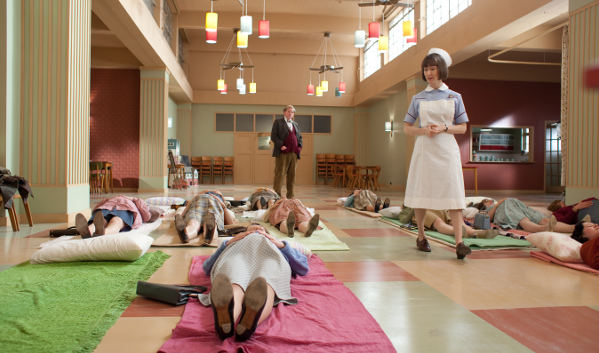In addition to the faculty of the Vanderbilt School of Nursing guest blogging for us each Monday morning about the previous night’s episode of Call the Midwife — airing on Sundays on NPT and PBS Stations nationwide at 7:00 p.m. Central, March 30-May 18 — we are thrilled to have a bonus blogger. Rachel Sykes, who did a practicum at the Vanderbilt School of Nursing in the summer 0f 2013, is a registered midwife and graduate from the University of Manchester, United Kingdom. She’s watched the show on the BBC and will provide a unique UK-perspective. She currently practices in a busy maternity unit in the Northwest of England. Read this week’s post by Margaret Buxton of Vanderbilt here.
SPOILER ALERT: Some posts may contain spoilers, so please be aware of that.
By Rachel Sykes
 It’s ‘handbags at dawn’* this week as the green eyed monster aka Trixie is present in Nonnatus House. Blonde bombshell Nurse Franklin (Helen George) is bitter about Jenny Lee’s (Jessica Raine) recent promotion to Sister, which she obviously thought she was in the pipeline for. A workplace full of estrogen is never without challenges! ‘Sister Lee’ relishes in her new role, running a tight ship which is very reflective of the ‘old school’ nursing and midwifery sisters, so typical of the 1950s era. There are still some of these types of nurses and midwives around today which I admit, I love (though they often scare me!). These old- fashioned types are professional, direct, ‘stand no-nonsense’ and are all round excellent at their job. Here in the UK and particularly within the nursing profession, senior nurses are known as ‘Sisters,’ which must sound strange to some, given that religious nuns are also known by this term. This reminds me of the time I was in a maternity unit in Nashville wearing my student midwife uniform (knee length white dress) and I was mistaken for a nun! I put on my best British accent and declared that it was ‘much too late for me to be a nun,’ then trotted off thinking how pure I must look!
It’s ‘handbags at dawn’* this week as the green eyed monster aka Trixie is present in Nonnatus House. Blonde bombshell Nurse Franklin (Helen George) is bitter about Jenny Lee’s (Jessica Raine) recent promotion to Sister, which she obviously thought she was in the pipeline for. A workplace full of estrogen is never without challenges! ‘Sister Lee’ relishes in her new role, running a tight ship which is very reflective of the ‘old school’ nursing and midwifery sisters, so typical of the 1950s era. There are still some of these types of nurses and midwives around today which I admit, I love (though they often scare me!). These old- fashioned types are professional, direct, ‘stand no-nonsense’ and are all round excellent at their job. Here in the UK and particularly within the nursing profession, senior nurses are known as ‘Sisters,’ which must sound strange to some, given that religious nuns are also known by this term. This reminds me of the time I was in a maternity unit in Nashville wearing my student midwife uniform (knee length white dress) and I was mistaken for a nun! I put on my best British accent and declared that it was ‘much too late for me to be a nun,’ then trotted off thinking how pure I must look!
There are some comparisons between nuns and midwives, in the sense that they represent a unique sisterhood. Midwives have to maintain a strong support mechanism for each other as the working life of a midwife certainly has its peaks and troughs. Many midwives experience difficult times in their careers, during which their resilience is really put to the test. Speaking of this, Jenny Lee is faced with the difficult task of caring for Mrs Aston (Seline Hizli) and her baby, fathered by a man with whom she had a brief affair. This is a difficult (and awkward!) situation for a midwife to be in the midst of. Having said that, a midwife’s role is to place women in the forefront of her care, at all times and without judgement. This can be challenging at times as it is natural to have our own personal views and beliefs about certain things. We are only human of course.
It must have been pretty refreshing for the midwives of Nonnatus House to listen to a male doctor so in tune with the process of normal birth and the psychological factors affecting it (although Sister Monica Joan was more interested in her ‘knit one, purl one, drop one, curl one’). Obstetricians often have opposing views to midwives as they are medically trained and differ in their philosophy. The midwifery ethos of care is to promote normality, caring for women from a holistic perspective. In the UK, obstetricians are only summoned when care falls outside of the midwife’s remit; when women experience complications. Many obstetricians in the UK have a good understanding of the midwifery model of care and often ask midwives for their opinions (which they love to give!).**
Sweet Nurse Miller (Bryony Hannah) who ‘wouldn’t say boo to a goose’ takes the reins and overrides Sister Evangelina’s (Pam Ferris) decision to transfer Nellie Short (Faye Daveney) to hospital. In any job, it takes courage to assert yourself over someone more experienced than you and this scene represents the strong midwife-mother relationship which is truly important for women. We see here the significance of listening to women and becoming familiar with not only their individual persona, but also their preferences and state of mind. In this instance, Nellie is dealing with the grief of losing her mother, contributing to her fear of birth which is likely to be exacerbated by her painful occipito-posterior (OP) labour, otherwise known as ‘back to back’ labour. In some circumstances, a baby will deliver in the OP position, or ‘sunny side up’ as Sister Evangelina calls it. Midwives often see OP positions approaching term, some believe it to be due to our modern day culture as women may spend more time slouching back in armchairs rather than on their hands and knees doing the house work, as they may have done in years gone by. I often advise women with a baby in an OP position to make sure they maintain an upright and forward position, with the legs open to maximise the pelvic outlet (always handy when you have to get a 6-9lb human being through there). I tell them ‘remember U.F.O.’ No, not ‘Unidentified Flying Object’ but ‘Upright, Forward, Open!’ This position will give the best chance of getting the baby in the optimum position for labour and delivery. So remember ladies…U.F.O!
In this scene, we see Sister Evangelina preparing Pethidine, a type of opiate drug given by intramuscular injection, which is used less often now in the UK due to its sedating effects. It has been replaced with Diamorphine (an opiate based drug), which is widely used by women who find it to be effective analgesia. Midwives may administer this in the hospital, birth centre or even the home setting. Women tend to opt for this as it aids relaxation and can often reduce the need for an epidural, which in turn helps them to remain upright…..forward…..and open!
Rachel Sykes is a registered midwife and graduate from the University of Manchester, United Kingdom.
*Rachel occasionally throws in some British slang for us to parse. According to Wikipedia, “handbags at dawn,” is “… a fight where the protagonists are unable or unwilling to seriously hurt each … , in reference to the way girls fight by hitting each other with their handbags. Handbags at dawn is therefore a combination of the above with an allusion to ‘pistols at dawn‘ style dueling to describe a conflict brought about by a perceived slight or offense to one’s honour but which is nevertheless unlikely to result in any serious injury.
**From Michelle Collins at Vanderbilt School of Nursing: “While physicians in the UK view midwifery care as the norm for the obstetric care of the majority of women in the UK, most US physicians have had little to no exposure to working with midwives. In the US, physician care for the majority of women has been the norm for decades, but the tide is turning on that. “
Missed our analysis of the Previous Season’s Episodes? Read them here.
